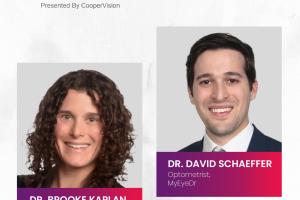Digital devices are now part of our everyday lives, and with the advancements of digital technology over the past two decades, daily screentime is a given for most patients.1,2
Since viewing a computer or digital screen often makes the eyes work harder, routine screentime habits can lead to the development of vision-related symptoms.3 These can include irritation/burning eyes, dry eyes, eyestrain, headache, tired eyes, sensitivity to bright lights, and eye discomfort.4 Accommodation-related symptoms have also been reported and include blurred near or distance vision after computer use and difficulty refocusing from one distance to another.4
The COVID 19 pandemic only accelerated screentime use, as people turned to their digital devices more and more to stay connected at work, school, and with friends and family.5
But four years later, where does digital device use stand today? A new report from CooperVision takes a fresh look at current trends in digital device use and digital eye strain.6
One critical finding from the report: Screentime hasn’t slowed, but instead continues to rise in the U.S.,7 along with more individuals experiencing symptoms of digital eye strain.8
Here is a snapshot of some key insights from the report, “A New Look at Digital Eye Strain.”6
Trends Point to More Hours on Screens
The report’s results are based on survey responses from 750 adults, aged 18-44, who lived in the U.S. and required vision correction. All survey responders wore either contact lenses or glasses, a requirement for participation to ensure the individuals interacted with an eye care professional.
More than half of respondents spent, on average, six or more hours a day on digital devices.9 Further, one in four said they spent an average of nine hours or more a day looking at a screen.10
Smartphones were named the number one device on which people spent the most time, with 79% of those surveyed affirming they used their smartphone for at least three hours a day.11 Of note, 62% said their smartphone usage greatly increased over the past two years.12 In addition to their smartphones, those surveyed indicated they were also spending increased time on other digital devices. TV was the second most popular digital device respondents used at 41%, followed by laptops at 39%.7
Digital Eye Strain Frequent and on the Rise
Not surprising, a majority said they experienced digital eye strain symptoms, and many at a frequent rate. Specifically, nearly 70% reported symptoms associated with digital eye strain,8 and nearly four in 10 said they experienced digital eye strain symptoms multiple times per week or more.13
When asked to explain the cause of their eye tiredness, nearly 50% believed it was due to screen time.14
Soft Contact Lens Innovations to Help Ease Eye Tiredness and Dryness
CooperVision’s MyDay Energys® daily disposable and Biofinity Energys® monthly replacement contact lenses combine an innovative aspheric lens design and advanced material technology to help address eye tiredness and dryness associated with digital device use.15 The lenses feature DigitalBoost™ Technology, a single vision aspheric lens design unique to MyDay Energys® and Biofinity Energys® that delivers a +0.3D boost, which may help ease strain on eye muscles so the wearer can shift focus from on screen to off with less effort.*16
Final Thoughts
The report makes it clear: Digital device use, and correspondingly, digital eye strain, are on the rise. And whether your patients bring up digital eye strain during their eye exam, a strong opportunity presents itself for ECPs to educate patients on digital eye strain and help them find solutions.
Access the full report here: https://coopervision.com/sites/coopervision.com/files/2024-02/digital-eye-strain-research-report.pdf, and discover more about MyDay Energys® and Biofinity Energys® for your patients. Also visit CooperVision’s Online Success Center for additional information and learnings about spheres and digital lifestyles.
* Based on a statistically significant difference of the mean change in Accommodative Microfluctuations and when compared to Biofinity sphere after reading on an iPhone 5 for 20 minutes held at a distance of 25 cm.
- Wolffsohn JS, Lingham G, Downie LE, et al. TFOS Lifestyle: Impact of the digital environment on the ocular surface. Ocul Surf. 2023 Apr;28:213-252. doi: 10.1016/j.jtos.2023.04.004.
- Pandya A and Lodha P (2021) Social connectedness, excessive screen time during COVID-19 and mental health: A review of current evidence. Front. Hum. Dyn 3:684137. doi: 10.3389/fhumd.2021.684137.
- Computer Vision Syndrome. American Optometric Association. https://www.aoa.org/healthy-eyes/eye-and-vision-conditions/computer-vision-syndrome?sso=y. Accessed Feb. 15, 2024.
- Kaur K, Gurnani B, Nyak S, et al. Digital Eye Strain: A comprehensive review.Ophthalmol Ther. 2022 Oct; 11(5): 1655–1680.
- Trott M, Driscoll R, Iraldo E, et al. Changes and correlates of screen time in adults and children during the COVID-19 pandemic: A systematic review and meta-analysis. EClinicalMedicine. 2022 Jun:48:101452.
- CooperVision (February 2024). “A New Look at Digital Eye Strain”. Report of online survey results (2023): N=750, Vision corrected patients. US Adults Ages 18-44 who wear corrective spectacles and/or contact lenses.
- CVI data on file 2023. US online survey: N=750, Vision corrected patients. US Adults Ages 18-44 who wear corrective spectacles and/or contact lenses. 62% increased smart phone screen time, 41% increased TV screen time, 39% increased laptop screen time for both work and personal use.
- CVI data on file 2023. US online survey: N=750, Vision corrected patients. US Adults Ages 18-44 who wear corrective spectacles and/or contact lenses. 31% experience at least once a week or less, 32% experience a few days a week and 6% experience every day.
- CVI data on file 2023. US online survey: N=750, Vision corrected patients. US Adults Ages 18-44 who wear corrective spectacles and/or contact lenses. 52% say the spend 6 hours or more.
- CVI data on file 2023. US online survey: N=750, Vision corrected patients. US Adults Ages 18-44 who wear corrective spectacles and/or contact lenses. 25% say they send 9 hours or more.
- CVI data on file 2023. US online survey: n=750, Vision corrected patients. US Adults Ages 18-44 who wear corrective spectacles and/or contact lenses.
- CVI data on file 2023. US online survey: n=738, Vision corrected patients. US Adults Ages 18-44 who wear corrective spectacles and/or contact lenses and use a smartphone. 62% greatly increased/increased for both work and personal use.
- CVI data on file 2023. US online survey: N=750, Vision corrected patients US Adults Ages 18-44 who wear corrective spectacles and/or contact lenses. 32% experience digital eye strain at least a few times a week. 6% experience digital eye strain every day.
- CVI data on file 2023. US online survey: n=586, Vision corrected patients US Adults Ages 18-44 who wear corrective spectacles and/or contact lenses and experience eye tiredness. 48% responded that excessive screen time is what causes their eye tiredness.
- CVI data on file 2024.
- Kajita M et al. Changes in accommodative micro-fluctuations after wearing contact lenses of different optical designs. Cont Lens Ant Eye. 2020 Oct;43(5):493-496. doi: 10.1016/j.clae.2020.03.003.






